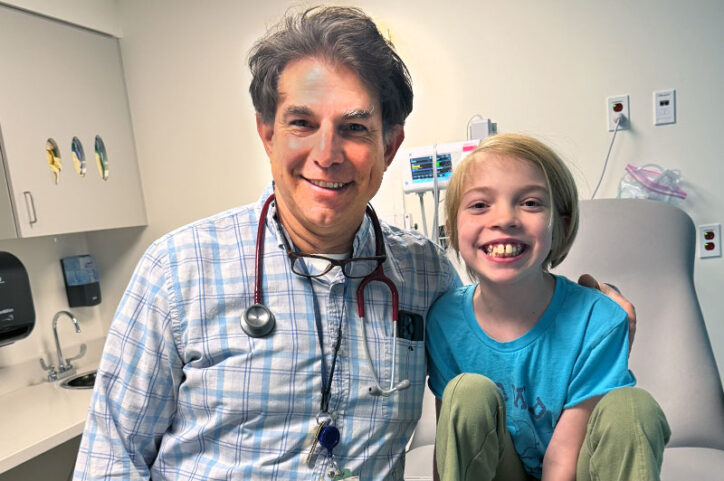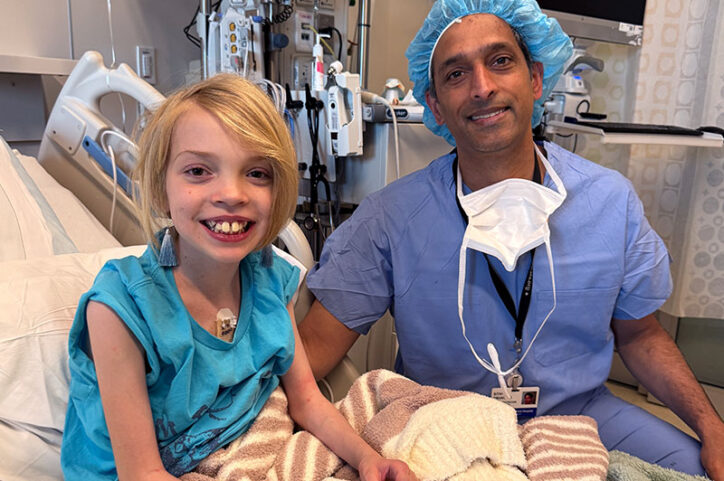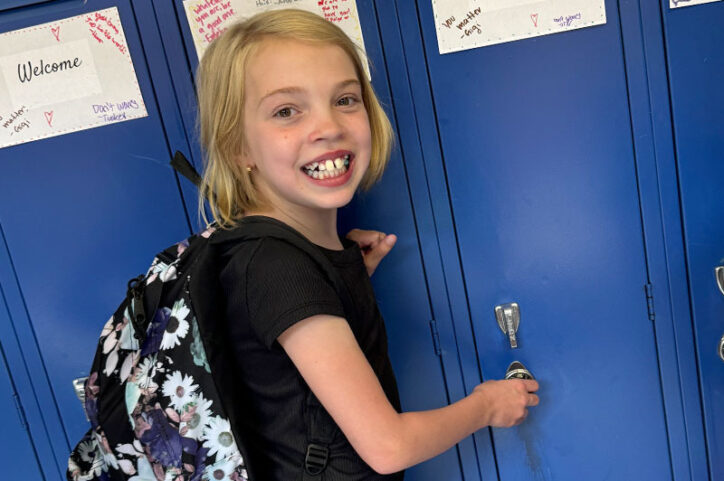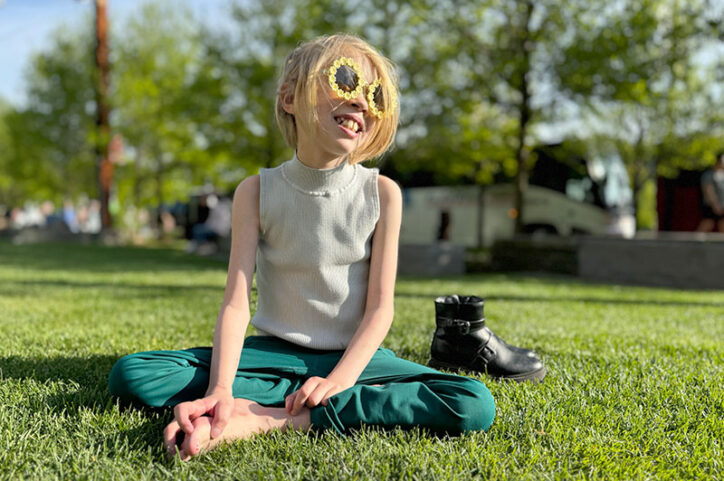Clara now runs, dances, and sings along to Taylor Swift thanks to a new life-changing heart surgery

The time had finally come. Only two weeks after a transformative heart operation at Boston Children’s, 11-year-old Clara Portnoy stood in a sprinter’s starting position on an open stretch of grass during her school’s field day. Surrounded by classmates and teachers, she was ready to go.
Born with a condition in which the structures on the left side of her heart were underdeveloped, Clara had avoided vigorous exercise all of her life. But she was tired of pacing herself and had often told her parents she longed to do “normal kid things.” It’s no wonder why she didn’t hesitate to run after surgery.
As seen in a video captured by her dad, Joe, Clara ran with the purpose and joy of someone who could be herself. “She ran in front of the whole school,” Joe said recently with Clara sitting by his side, too shy to say much about her big moment. “And it was awesome.”

A series of heart procedures started before birth
Clara’s run came after a particularly difficult year in which it looked like the last surgery she had was not working. She was fatigued, not eating, and not feeling well. She had missed almost the entire school year.
Clara already had several extensive procedures throughout her early life to improve her heart and circulation — starting before she was even born. While still in the womb, she was diagnosed with severe aortic valve stenosis along with evolving hypoplastic left heart syndrome (HLHS), which had caused her left-heart structures to not develop properly. She underwent a fetal cardiac intervention, performed by a team led by Dr. Wayne Tworetzky, a cardiologist and director of the Fetal Cardiology Program. The intervention aimed to prevent her condition from progressing to HLHS.
But even after the intervention, the left side of Clara’s heart still wasn’t developed enough to handle circulation. After she was born, Clara was transferred to Boston Children’s Cardiac Intensive Care Unit (CICU) and nine days later underwent the Norwood — the first in a series of three procedures that would enable her to survive with HLHS. Five months later she had the Glenn, and when she was 3 she had the Fontan. While the Fontan can be effective for some children, in others it can have negative effects on the liver, bowels, and lungs.
That’s what was happening to Clara. Her heart and heart valve function had also started to deteriorate. Clara’s heart team in Denver, which took over her care after her family moved to Colorado, told Joe and his wife, Joanna, that the specialists had run out of options. Clara would need a heart transplant.

A familiar heart team offers a better alternative
Clara and her family, though, soon found hope in a familiar place. The Denver heart team mentioned there was a possible alternative for Clara. “They said there is someone in the U.S. doing this new special type of surgery where they would reconnect everything in a different way and potentially avoid a heart transplant,” Joe recalls. “Joanna said, ‘Is it Ram Emani?’ They replied ‘Yes.’ We were like, ‘Of course it is Ram Emani.’”

How the reverse 1.5 ventricular repair helped Clara
The reverse 1.5 ventricular repair partially undid Clara’s Fontan circulation and now involves her left ventricle in the circulation process, but at half of its normal workload. Instead of pumping blood throughout her body, her left ventricle pumps lower-body blood to her lungs. Her right ventricle instead handles the heavy work of pumping blood throughout her body.
This new circulation lowered the pressure in Clara’s veins, improved her organ function, and, most importantly, allows her to increase her cardiac output through exercise — as her joyous run at school illustrated.
Dr. Sitaram “Ram” Emani, a Boston Children’s cardiac surgeon and director of the hospital’s Complex Biventricular Repair Program, had performed Clara’s heart surgeries and knew her and her family well. The family also knew Dr. Tworetzky well. He alerted the Denver heart team to the “special” surgery that the Benderson Family Heart Center had developed: a reverse 1.5 ventricular repair. Dr. Tworetzky later told the family Clara could possibly be among the first few patients in the world to have it.
When Clara came to Boston Children’s in May, her left ventricle still couldn’t handle a full workload, but her care team saw that it had developed just enough to help with circulation. The surgeries she already had put her in this position; she was an ideal candidate for the reverse 1.5 ventricular repair. “This new circulation substantially improves her blood flow,” Dr. Tworetzky says.
Full of life, full of joy — a new beginning for Clara
Joe and Joanna are thrilled by the improvements they see in Clara. “She now has a pink face, pink lips — she looks full of life,” Joe says. “And her life is totally different. She has energy to do things. She gets herself up in the morning, walks a quarter-mile to the bus stop, does a full day of school, and then walks home. Then she goes out and plays with friends. To go from being told she needed a heart transplant to now knowing that we may only someday need to fix her heart valve — it’s amazing.”
Clara looks forward to expending her newfound energy with her sisters, 10-year-old Eleanor and 8-year-old Poppy. She also enjoys dancing, climbing trees, creative writing, and listening to Taylor Swift.
“Even at her lowest points, we always thought we have much to be grateful for,” Joe says. “She wasn’t in the best of health, but we took joy in the fact that she was alive, and she has her fingers and toes. Now, she’s better, so there’s even more to be joyful about.”

Learn more about the Complex Biventricular Repair Program or request a second opinion.
Related Posts :
-

Treating MAPCAs with unifocalization surgery and cardiology care
Children born with a rare form of tetralogy of Fallot (ToF) face a challenging type of congenital heart ...
-

After surgeries to treat HLHS, Carter is healthy and happy at home in Florida
Carter Miller loves action. The 4-year-old Florida resident enjoys riding on golf carts and flying high on swing sets. ...
-

‘We never stopped believing’: Benny’s journey with liver cancer
Earlier this year, 12-year-old Benny helped his dad, Ben, build a deck around his family’s pool. Moving boards, handing ...
-

Choosing fetoscopic spina bifida care for Hadley
When Katie and Derek learned in 2024 that their daughter Hadley would be born with spina bifida, they quickly set out ...





